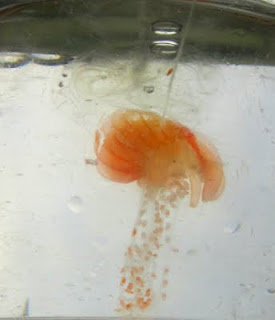3 Lobsters in a Pot & the Biggest Fish in the North Haven
 |
3 lobsters - weighing 1 to 2 pounds each |
 |
No Way!!!! |
We had not checked our Lobster trap for a while because of bad weather. I knew the bait would be eaten by crabs the very first night. With a brake from the weather Dad & I were finally able to go fishing again and get our one trap. Three Lobster! Unbelievable! We have only caught 1 other lobster in 5 years! now bring our total to only 4. I was so happy.
 |
It tastes good I've never eaten Lobster before. |
 |
| everything is just ducky. |
 |
| Am I Dreaming? Pollack - I Caught this fish in the North Haven as well. A new North Haven record... the biggest ever! (for us or that we know of?) |
Lobster Last Night!
Fish & Chips Tonight!
 |
Cool Jellyfish Invasion! |

Comb Jellyfish Hula Skirt Siphonophore
A note from Nick Riddiford Island Naturalist.
"Henry and Tommy Hyndman brought me an amazing collection of jellyfish and other plankton collected this evening from North Haven. The highlight was definitely the spectacular Physophora hydrostatica, and amazing collection of orange body, transparent tubes above ending in a narrow cylindrical float and with a series of threads trailing below, with yellow blobs attached. It has even been given an English name – hula skirt siphonophore. It is a deep sea species but, being a slow swimmer, it is vulnerable to being brought to the surface by currents. Five were collected, so there must have been many more.
Other jellyfish and allies taken comprised a blue jellyfish Cyanea lamarckii – which occurs from time to time; a mauve stinger Pelagia noctiluca – which normally occurs further out to sea. We had a mauve stinger invasion two years ago.. The previous Anomalocera patersoni record for the isle was in 2009. Henry was involved in that too! (when he brought me all those ghost shrimps). a number of the comb jelly Bolinopsis infundibulum – a very common summer visitor to Fair Isle shores; and Ptychogena crocea - a thecate hydroid usually found on rocky substrates well below the tidal zone.
The collection also included numerous smaller plankton. By far the most numerous was a Calanus copepod – probably Calanus helgolandicus which is a recent late summer invader of our waters (replacing Calanus finmarchicus which has disappeared in response to climate change). The most interesting capture was a blue and green coloured copepod called Anomalocera patersoni. Some of the blue markings appeared luminescent in some lights. This is a surface waters dweller of North Atlantic origin, quite widespread but having suffered a high decline in population since the 1970s.
The cutest planktonic capture involved a 1 mm long transparent replica of a crab. It was indeed a crab, an early instar of the common shore crab Carcinus maenas. A tiny, bright crimson shrimp keyed out to Apherusa jurinei, I have found an earlier Fair Isle record for Apherusa jurinei - from June 1998! 2nd recorded for the isle but probably a regular (overlooked) component of the inshore gammarid community."
The Three species highlighted in bold appear to be first Fair Isle records.
Strangely, North Haven was empty of jellyfish this morning when we released to beasties back into the sea.
Cheerio! Nick
Thanks for that Nick! Henry


